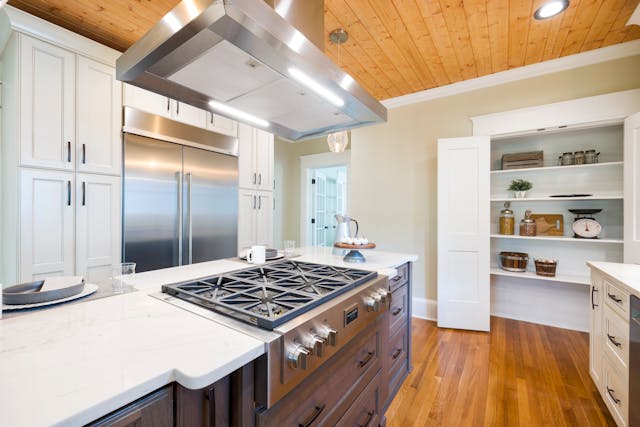Kitchen Ventilation Fan
They help to create a healthy and clean environment in your Kitchen Ventilation Fan by removing the smoke, odors or moisture. Picking the right one means knowing what it does and how best to improve air quality.
The Purpose of Kitchen Ventilation Fans
The main job of a kitchen fan is to prevent the contaminants staying in air from spreading around. Inadequate ventilation will ensure that particles from your cooking settle on surfaces, resulting in accumulated dirt and bacteria.
- This moisture and heat prevent buildup
- Ensures a pleasant fragrance in the kitchen
- Less airborne grease accumulation
Kitchen Fans Galore

Individual kitchens will need various types of ventilation depending on layout, and how heavily the stove is used. There are various types of it that include wall-mounted, island-mount and below-cabinet fans which gives you multiple advantages a fan.
- Wall-mounted fans: Simple to install; Suitable for most kitchens
- Island fans: ideal for open-concept kitchens
- Under-cabinet fans: For Small layout kitchens
Things to Consider When You Choose Your Exhaust Fan
For selecting an appropriate ventilation fan, its size and noise are just a few of other factors to be considered. This directly effects the performance and usability of each feature.
Choosing the Right Fan Size
Efficiency Fan size is in proportion to efficiency In somewhat larger kitchens, a smaller fan might not provide enough ventilation.
- Mean by Kitchen Ventilation Fanarea Size
- Fits over your cooking area accurately
- Enables maximum airflow
Noise Level Preferences
The tone of sound in the type may differ. A quieter cooling fan for those who cook a lot Most manufacturers rate fan noise in sons, with the lower numbers being less audible models.
- Desirable noise level: 1–3 sons.
- More power louder fans
- Read reviews to learn how loud a projector is (user feedback on noise)
Fan Power and Airflow Rate
The power and airflow determine how effectively the fan can remove air pollutants. In general, higher CFM (cubic feet per minute) is better performing.
Understanding CFM Ratings
The air exchange is faster in case of a higher CFM rating, which matters to the kitchens with high volumes of cooking. But low CFM range hoods are often far less effective and high-capacity fans can be overkill for simple stovetop cooking.
- Standard kitchens need 200-400 CFM
- For heavier cooking 400-600 CFM is recommended.
- Match CFM to kitchen backdraft requirements
Properly Sizing Fan Power for Cooking Styles

This particular means understanding how you cook and either choosing a fan that will deals with those needs, or purchasing new appliances all together. A more powerful Kitchen Ventilation Fan is necessary if you make things that require high heat to cook. You will need the medium fan speed even if your cooking is minimal.
- Variable speed feature
- Stops over ventilation in smaller kitchens
- Saves on energy costs
Ducted vs Non-Ducted Exhaust fans
Below are some areas where choosing the right fan either ducted or ductless can significantly influence ease of installation and effectiveness. Both styles have their own benefits that accommodate different kitchen designs.
Advantages of Ducted Fans
Ducted fans performed better at removing contaminants since they exhausted outdoors. These are perfect for kitchens with a larger space and where thick dense smoke emanates.
- One of the best space savers in this list, and does it while delivering quite well on air filtering performance.
- Additional ducting required to be installed externally.
- Ideal for commercial-use cooking areas
Advantages of Ductless Fans
It’s easier to install ductless units than other types of fans as you don’t need external ducting. These pull fumes up through filters and then recirculate the air back into your kitchen.
- Perfect for apartment life or smaller kitchens
- Reduces installation costs
- Filter replacements from time to time are necessary
Choosing the Right Filters
Filters are needed to help catch the grease and odor. Knowing the varieties of filters make available can help you decide which one suits your maintenance taste.
Types of Filters
Filters: These come in both mesh and activated charcoal forms. You can reuse mesh filters while charcoal ones require regular replacing.
- Pros: Mesh filters are affordable and can be reused after cleaning.
- Charcoal filters: good for odor bulbs, disposable.
- Combination filters: A combination of grease and also odor control.
Filter Maintenance Requirements
Maintenance of each filter type differs to others. Mesh filters need to be washed out relatively frequently and charcoal filters, on the other hand, should also not overstay their welcome as you will begin experience decreases in your units efficiency.
- Clean mesh filters monthly
- This means switching out charcoal filters every 3-6 months.
- Consult the mfg. Guidelines for maintenance,
Fan placement and position

It helps in proper ventilation if placed correctly. It is essential that fans are installed at the right height and position to your cook top.
Optimal Height and Position
With most ventilation fans, the recommended distance from the cooking surface is between 24 and 30 inches. This guarantees that smoke and steam is suitably caught.
- Installation height 24–30 inches above cook top
- Do not sit near windows
- Optimizes airflow and fuel efficiency
Kitchen Configuration Thing to consider
There are points of interest to ensure that you choose the right location for your exhaust fan and a kitchen layout plays a role in this. Island Fans, for example, work best in open spaces while wall-mounted fans function well when put inside an enclosure.
- Cyprus Kitchen Extractor Solutions for Centrally Located Island Kitchens
- Wall fans are ideal for traditional layouts
- Keep air pathways clear
Energy Efficiency Perspective
Energy-efficient fans can lessen your usage of electricity, while still let in plenty of fresh air. By design, low-energy fan choice reduces costs and environmental impact.
Energy Star-Rated Fans
Energy Star rated fans provide more efficient operation using up to 70% less energy. These frequently have variable speed to match the generously altered cooking necessities.
- Saves on electricity bills
- Green- Should be the Goъd Assistant
- May offer local utilities incentives
Choose Variable Speed Fans
Speed adjustable fans are a boon as they give you the ease of controlling ventilation force. The Fanshade allows more customization which means less wasted energy and even happier users.
- Helps prevent from over ventilating for light cooking
- Adjusts fan speed for current cooking requirements
- Reduces Noise and Energy Drain
Budgeting And Cost Considerations
Of course, the right fan for you will also rely on your budget. Prices range considerably depending on features, power, and brand.
Find the Best Budget-Friendly Solution
Set a budget before shopping. Basic features are pre-installed in cheaper fans, where the premium models may have some more added functionalities.
- Look for sales and discounts
- Check brands & customer reviews
- Factor in long-term maintainability
Calculating Long-Term Value
Also, a good Kitchen Ventilation Fan may have higher initial costs; however, it could save you money in the long run regarding energy consumption and build quality.
Invest in reputable brands
- Les modèles robustes réduisent la fréquence de remplacement
- Fans which can save you bills on your electricity costs due to their energy-efficient nature.
Tips on Installation & Maintenance
Fitting and maintaining are the essential steps for high efficiency of your ventilation fan. Routine maintenance will prolong the life of your fan and upgrade air quality.
Installing a Ventilation Fan
Ducted fans are generally recommended for elaborate arrangements where professional installation may be necessary. Make sure that the fan mounts snugly to eliminate any rattle.
- For ducted fans, always go to licensed professional
- Secure mounting reduces noise
- Read the installation instruction closely.
Best Ways for Lasting Maintenance
Cleaning filters and checking for loose parts every few months are actually necessary in keeping a fan. Immersion of the motor part can be done yearly too. It can also damages from smoke, dust and grease further prevents these hazards as a result of clearing it on traditional basis.
- Change Filters 2 to 3 Months
- Observe for obstructions in ducts
- Maintenance guide supplied by manufacturer
Conclusion
Get The Right Kitchen Ventilation Fan For Your Smoke Free Cooking Experience From choosing the right size and model to increasing energy efficiency, all of it contributes significantly towards improved air quality in a kitchen. However, by speaking with their local HVAC professional and examining basic wants and needs of a ventilation fan, homeowners can find the best fit for its application.
Difference Table of the Content
| Aspect | Wall-mounted Fans | Island Fans |
Under-cabinet Fans
|
| Ideal for | Suitable for most standard kitchen layouts due to ease of wall placement. | Perfect for open-concept kitchens where the cooktop is on an island. |
Best suited for compact kitchens with limited overhead space for larger installations.
|
| Installation Requirements | Generally straightforward installation; mounted directly to the wall above the cooktop, making it accessible for direct ventilation outdoors. | Installation requires careful planning as these fans hang from the ceiling above the island, needing robust support structures. |
Typically mounted beneath cabinets directly over the stove, saving space and keeping ventilation low-profile.
|
| Advantages | Efficient for general ventilation in enclosed or semi-enclosed kitchens. Frees up overhead space for additional cabinets or storage. | Ideal for kitchens with minimal wall space; enables central ventilation in open layouts. Effectively captures smoke and steam from all sides. |
Great for smaller layouts; positioned close to the stove, it offers direct ventilation in a confined area without extensive installation requirements.
|
| Drawbacks | Limited to specific placements on walls, making it less versatile for certain kitchen designs. | Requires more space and often professional installation due to hanging placement. |
Limited airflow power; may not be suitable for kitchens with heavy cooking or large cooking surfaces.
|
FAQs
- What size of HVAC fan do I need?
Consider the square footage of your kitchen and how often you cook to determine size. These are ideal for a regular kitchen, and normally come with 200 to 400 CFM.
- Would you prefer ducted or and ductless fans?
Finally vented out of the home like duct fans are better for get rid off pollutants, that is why they tend to be used in bigger kitchens. Ductless fans are much simpler to install and best for small areas, but you may need more frequent maintenance.
- How often do I need to clean or change my filters?
Mesh filters are to be cleaned monthly while charcoal filters replaced every month or 3-6 months depending on use. Maintain to be best
- At what height to put the kitchen hood
For an ideal capturing smoke and odor effectiveness, most specialists agree for placement of kitchen ventilation fans 24-30 inch over the cooktop.
- How can I improve the energy output of my stove fan?
Choose Eco Star-rated fans, opt for custom speed limits, and ensure on-time checkups to reduce energy use and costs.
If you want to know more about us then click here.

[…] you want to know more about us then click […]